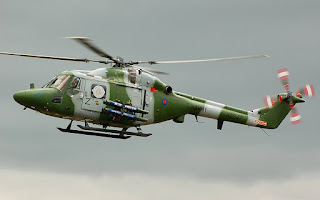The Westland Lynx is a British multi-purpose twin-engined military helicopter designed and built by Westland Helicopters at its factory in Yeovil. Originally intended as a utility craft for both civil and naval usage, military interest led to the development of both battlefield and naval variants. The Lynx went into operational usage in 1977 and was later adopted by the armed forces of over a dozen nations, primarily serving in the battlefield utility, anti-armour, search and rescue and anti-submarine warfare roles.
The Lynx is a fully aerobatic helicopter with the ability to perform loops and rolls. In 1986, a specially modified Lynx set the current Fédération Aéronautique Internationale's official airspeed record for helicopters (category excludes compound helicopters) at 400.87 km/h (249.09 mph), which remains unbroken as of 2020.
Several land and naval variants of the Lynx have been produced along with some major derivatives. The Westland 30 was produced as a civil utility helicopter; it was not a commercial success and only a small number were built during the 1980s. In the 21st century, a modernised variant of the Lynx was designed as a multi-role combat helicopter, designated as the AgustaWestland AW159 Wildcat; the Wildcat is intended to replace existing Lynx helicopters. The Lynx remains in production by AgustaWestland, the successor to Westland Helicopters.
The Lynx is a multi-purpose twin-engine battlefield helicopter, of which specialised versions have been developed for both sea and land-based warfare. A distinguishing feature between early and later aircraft is the undercarriage: early Army versions of the Lynx were equipped with skids, while the Naval and later models have been outfitted with wheels, a requirement for easy ground handling on the deck of a warship. Early versions of the Lynx were powered by a pair of Rolls-Royce Gem turboshaft engines and had a four-blade rotor, mounted on a rigid titanium monobloc rotor head of the kind pioneered by the MBB BO105 a few years earlier. The innovative blade design comprised a honeycomb sandwich structure made out of composite material. For shipboard stowage, both the rotor blades and tail can be folded. Lag dampers were incorporated but these are not required in flight (owing to the rigidity of the monobloc rotor head). In flight, the main rotor is kept at a constant speed, simplifying aircraft control; the rotor also features a vibration absorption system. More details
